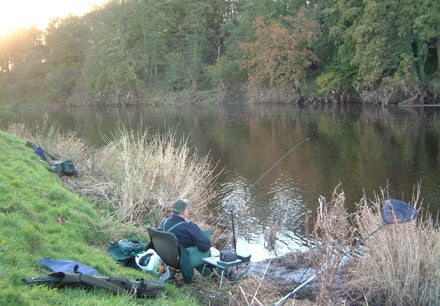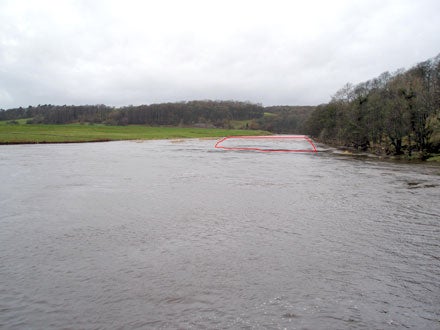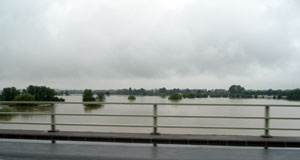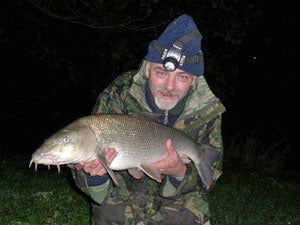Reading River Conditions In AutumnRecently I had a phone conversation with Ian Marsh, my fishing partner of the last few years, about whether I was interested in fishing the river that evening. The river being the river Ribble for me, as many on this site will know.The backdrop to this conversation was that it had rained quite heavily during the previous night and moderately steady all morning, forecasting it to start drying up from 13:00 hours. The river had actually peaked at 2.5 metres high. Generally, I would usually be up for it big time with a predicted one metre on at the time of arrival and subsequently falling during the session. However, this was the first substantial rain we’d had during September and I’d notice the weekend before, when the river was low, that the warmish weather we’d had from mid August onward had encouraged the bottom weed to grow again. Interestingly, the poor summer and the floods we’d had, had suppressed its growth substantially during the normal growing season. Added to this, the weird weather of the spring/summer was causing the leaves from trees to turn brown and drop off and the herbage to die back; about a month earlier than normal in this region. The washing line syndromeThe combination of the four – leaves, weed, dead herbage and high water – makes for the dreaded ‘washing line syndrome’. That being, a collection of all three on the line, giving the appearance of washing hung out on it. The extra flow pressure created by such higher water against all this debris collecting on the line, makes the leads/feeders and bait move out position very quickly.Increasing the weight size of the leads or feeders only serves to allow even more garbage to build up on the line before the inevitable happens and you have to reel in to strip the debris off. The constant reeling in and pulling the line through the collected rubbish in the tip ring causes the line to pigtail badly. And on the Ribble, because you may be fishing across the river at 40 yards, the yardage of pigtailing can be substantial, as much as 20yds. In summary fishing in these conditions I find infuriating. So I declined my mate’s offer after I’d pointed this out to him. Leaving him to make his own decision as to whether he was going or not. He didn’t go either! It is critical to read and understand the conditionsAutumn time on most rivers, because of the above events, can be frustrating and infuriating, but the fish will feed well when there’s water on it. So it is in my view, critical to read and understand the conditions and use them to your advantage.So how do you recognise the advantages when they present themselves to you? I firmly believe you must understand what is happening in and around the river and its moving water column under such conditions. So let me take you through a typical rising river in early autumn. All rivers start their life on high ground, while that might be stating the obvious, I’d be a rich man if I had a fiver for every time I’d heard other anglers say to me, “I don’t understand why the rivers so high today, because we’ve not had much rain yesterday and/or last night round these parts.” That statement may be true, but rivers rise very little with direct rainwater falling in its channel. It’s what falls on the whole catchment area that is the deciding factor, and in particular how much has fallen in the headwaters of the whole catchment area over the last 24 hours. In general terms, the highest ground gets the most rainfall. Little rain lower down doesn’t mean it hasn’t put down substantial amount on top of the hills where the headwaters start. I make the last statement based on where you are on the river at any given time, be that the upper, middle or lower section. The further down you are on a river the more tributaries join it. These have an impact on the river by adding water volume to it. The reference to ‘whole catchment area’ takes into account such joining tributaries. And on the larger rivers of England and Wales, it is quite possible for it not to rain in the headwaters of the main river, but hammer it down in the headwaters of one or two of its main tributaries. Under these conditions it would raise the level of the main river from these tributaries downstream but very little above where they entered. I state ‘very little’ because there would be some back up from the confluence, but it’s doubtful that the effect would be detectable a mile up from there. The only way I know of when the river above would rise significantly, is when the volume of water coming down the tributary(s) was greater than the main river flow, causing it to stop flowing and back up, increasing the depth upstream, as the main river water would be unable to move downstream. As the rising water (flood pulse) moves down from the headwaters it starts to pick up debris as listed above. In turn, it picks up more water from the now swollen headwater streams and riverlets, increasing the flow rate even further. These streams and riverlets have also picked up debris. The flow rate by this time is strong enough to keep the materials in suspension, and on a relentless move down the river, aided by the buoyancy of much of the matter. Much of this material is hidden beneath the surface and swirls about in the current and water column. This in effect is the washing that collects on your line. Whilst keeping as much line out of the water as possible will minimises it to some extent, inevitably it does collect on the line that’s in the water. It’s frankly the law of ‘washing,’ and there’s no way around it. So it goes without saying, that with the first floods of autumn, the rivers are carrying lots of this type of material and as the water increases in height, the more it collects and carries. A flood at this time of year must be carrying many hundreds of tonnes of vegetation matter and all of it is intent on ending up on the line of any foolhardy angler that had the temerity put it there in the first place. Nope, under these conditions the best place to be is on a Stillwater, or at home watching the telly, biding your time until the flood has peaked and the river starts to drop.
Not all bad newsHowever, it is not necessarily all bad news, providing the water stays high for at least 24 hours, and the leaves have come off the trees, as such floods scours and purges the river of them. It’s also beneficial if it’s accompanied by strong winds, which blow the leaves into the river.What’s not helpful from an angling point of view is a short flood of a flash nature.All this does is distribute the leaves on the bank lower down in the mid and lower sections. The leaves then dry out and get blown back into the river, and/or are picked up again when the water rises on the next flood.
As the peak of a flood pulse passes, there comes a point when the flow rate lessens, as it does so it will no longer support the vegetation matter in suspension, causing most of it to fall out of the water column and to the bed of the river. This generally happens on the bends first where the flow rate slows even further. Secondly on the riffles (rapids) when the boulders start to show above the waterline trapping the leaves. When this point is reached, it’s the time to get on the river and fish for the barbel, as they will still be feeding with gusto, and you know the river and any debris coming down will continue to decrease as your session goes on.
But the rewards are thereAs these conditions are reached, yes you’ll have to put up with some ‘washing’ but the rewards are there for those who set forth on the rivers.Cautionary note, flooded rivers are dangerous places and banks you thought were safe get undercut and can be hidden by the water height. Keep away from the water’s edge when playing and landing fish. One of my mates, whilst fishing on his own, experienced this, and went in whilst playing a fish. He lost his landing net, but it could have been far, far worse. Whilst the above is indicative of all rivers, the retention time of ‘washing’ will differ dependant on the length, depth and flow velocity of each river, but hopefully you now have a guide to work it out for yourself on your river! Next week: ‘Playing the Flood’ |
Welcome!Log into your account














